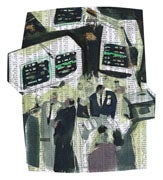The economy of Chinahas surprised the entire planet by growing at the world’s fastest rate. In recent years, its growth rate has been above 10%, and signs indicate that there will not be any significant slowdown, at least for the moment. All eyes are on the Chinese market, especially among global experts who analyze variable rate investments. So far this year, prices on the Shanghaistock exchange have surged 60%, and they have increased 130% over the past year. These kinds of returns are so much higher than on Wall Street or in Paris, Londonand Frankfurtthat many foreign investors are starting to distrust China.
Alan Greenspan, former president of the Federal Reserve, was the first person to sound the alarm. Nicknamed “The Master,” Greenspan has had more influence on global stock markets than anyone else in recent years. Greenspan said he fears a “dramatic contraction” on the Chinese market, although he added that the global economy should be able to overcome such a drop if it has sufficient flexibility. “It is clearly unsustainable,” Greenspan said in a video sent from Washington to participants in the recent Expomanagement conference in Madrid. “At any moment, there is going to be a dramatic contraction.”
In his judgment, this correction can damage the standard of living of Chinese families and tempt the government of that country to use its reserves to prop up the market in order to avoid social disruptions. But the infection could spread much further, given the fact that cheap imports from China have been one of the main engines of global growth, along with workers from Eastern Europe and lower interest rates.
“Over the last five years, the world as a whole has grown more rapidly than in any other period in global history,” Greenspan said. “This cannot continue, and it is not going to continue because this adjustment is too rapid.” In order to head off any damage, the global economy must be flexible enough to absorb any [downward] shock in [stock] prices, he noted.
Speculative Movements
Juan Carlos Martínez, an economics professor at the Instituto de Empresa business school in Madrid, agrees with Greenspan. Martínez believes that the recent rise in Chinese stock prices is fundamentally the result of “speculative movements.” However, he also recognizes that rising prices “do show strong progress in the economy of that country.” He warns, however, that “those who have propelled the Chinese market higher are largely local investors who feel that variable rate investments are very attractive [there]. The problem is that investors [in China] are borrowing money in order to invest. If they lose money in the stock market and they wind up unable to pay their debts, the complications could spill over into the financial sector.”
Normally, any bursting of the bubble spells trouble for the bulk of the economy, as was the case in the United States in 2000 when shares of high-tech companies plummeted. Yet history suggests that this won’t happen in China. Between 2001 and the end of 2005, the Shanghai Composite Index lost half of its value, even though the country’s GDP grew by 46%. And while the Chinese economy is the fourth-largest in the world, the value of its stock market represents only about four percent of the entire global stock market.
The Chinese government demonstrated that it shares Greenspan’s fears by tripling its tax on stock transactions in a clear attempt to cool off the over-heated local market. The same day this measure was announced, the CSI 300 index fell by 6.8%. That index charts the country’s largest companies in yuan [Chinese currency], and it is traded in Shanghai and Shenzhen. Although the market has calmed down recently, investors continue to fear that the Chinese government will once again impose new measures in order to slow down the heated-up market.
According to Martínez, higher taxes and continued fears of new measures by the government “have generated altitude sickness in Asian markets and led to capital flight.” Martínez believes that “it is too early to tell if the Chinese authorities’ latest measures will be effective. However, the important thing is that the government has decided to put a brake on speculation.”
Before raising its tax on share transactions from 0.1% to 0.3% last May 18, the Chinese government increased interest rates as well as cash deposit requirements for banks. It also deregulated its currency with respect to the U.S. dollar. All of these measures were intended to cool off the economy and address excessive liquidity. Nevertheless, those measures did not have any major repercussions on the stock market, which continued to reach a succession of record highs.
Analysts at Citibank explain in a recent report that “the goal of authorities is to moderate the increase, not to provoke a collapse of the market. It is within the current dynamic to combat the growth of liquidity, while gradually increasing flexibility in the functioning of the market. [The government] is also reducing speculation in other markets, such as real estate.”
Bearish on China, Bullish on Latin America
Renta 4, the Spanish brokerage firm, believes that the current situation in Chinese markets “should not lead to any panic or overall lack of confidence in the Asian region.” However, it recognizes that “the situation invites caution.” Rafael Pampillón, a professor of economics and an analyst at the Instituto de Empresa, believes that the greatest danger for the Chinese stock market is that the United States, one of its main trading partners, will cool off and wind up having a negative influence on Chinese companies. “The Chinese market is sky high at the moment, and any one factor could provoke a collapse,” says Pampillón.
For now, international investors are continuing to reduce their exposure to the Chinese market. During the first week of June, they withdrew more than $1.1 billion from the Chinese stock market. For Asian emerging stock markets as a whole, that figure rose to more than $1.4 billion, making it the third largest week for capital flight in recent years.
Precisely the opposite trend is taking place in Latin America, where the leading stock markets are experiencing a good year and steadily winning the confidence of global investors. Brazil and Mexico, the two most important markets in the region, are attracting the largest inflows of money.
The numbers speak for themselves. The Bovespa index of the Brazilian market has gained more than 15% in value so far this year. The main index for the Mexican stock market has gained more than 17%. The IPSA index, which comprises the 40 leading companies on the stock exchange in Santiago, Chile, has gained more than 20%. For its part, Morgan Stanley’s MSCI American Latin has experienced a 20% rise through June.
These kinds of returns are impressive when you look at the way global markets are developing overall. So far this year, the Dow Jones in New York has risen by more than 7%. In Europe, the FTSE of London has gained a little more than 4%. The Cac 40 Paris in France has gained 6.5%. The best performer in Europe has been the Dax in Frankfort, which has risen by more than 15%. In Asia, Japan’s Nikkei index has grown by a meager 3.2%.
Placing Their Bets on Brazil
The funds that invested in Latin America have been the strongest performers over the last three years. According to data from Morningstar, those funds have achieved an average of 194.3% [during this three-year period], with some funds managing to gain more than 250% in that period. This was the case with Credit Agricole Funds Latin America Equities S, which has shown growth of 266.7% since 2004. “I believe that Latin America is a profitable place to put your money despite the fact that the high rate of return brings greater risk. However, we have good expectations about the region’s economic performance for the rest of this year,” notes César Betancur Cañola, professor of financial engineering at the University of Medellín in Colombia.
According to a Merrill Lynch survey, 81% of fund managers who invest in emerging markets preferred to invest in Brazil, whose market became the largest in Latin America in early June, surpassing a market capitalization of $1 trillion. The Brazilian market has been benefited from higher metals prices, which have contributed to a doubling of corporate profits. At the same time, the Brazilian currency, the real, has shown its strength. (It appreciated by 19% relative to the dollar during the past year, and the real was the currency that had the highest returns among the world’s 16 most highly traded currencies). Another positive factor is that unusually high interest rates have attracted international investors to Brazil.
On June 1 alone, the total value of Brazilian shares rose by $1.02 billion, as the Bovespa index advanced by 2.2%. The index has risen by 45% during the past year, and has more than quadrupled since 2002.
Foreign investors are placing their bets on Brazil because there are such good prospects for economic growth there. Foreign capital represents 34% of all shares traded this year, 22% more than in 2000, according to the Sấo Paulo stock exchange. “Brazil offers the sorts of growth opportunities that investors have already experienced in other markets and investors are buying on their expectations,” Fabio Spinola, who administers 1.7 billion reals for Quest investment, told Bloomberg.
Something similar is happening in other countries in the region, where the prospects for economic growth are also very good in coming years. “Latin American stock markets are a reflection of the region’s favorable economic situation compared with the rising prices in China that result from market speculation,” notes Martinez. Latin America markets are “also benefiting from high global liquidity,” he adds.
Betancur stresses that “high prices in raw materials, high global liquidity and strong internal demand” are some of the reasons why analysts maintain their belief in the region’s performance. “Capital flows continue to arrive, and that has enabled us to create jobs and improve salaries. This is reflected in an increase in internal demand and loans, which also boost growth. Brazil is going to continue to be the main player. Not only has it benefited from capital flows, but it is also a large exporter.”
Along the same lines, Pampillón believes that the markets are benefiting from a strong inflow of dollars into the region. “This is permitting [Latin America’s] currencies to appreciate significantly,” he says. The dollars “come into the region as a result of exports now that global demand has peaked for Latin America’s main products, from soy beans to coffee, iron, steel and textiles.” Other factors behind the influx of dollars are that “foreign direct investment is also growing, and people are investing directly into [the region’s] stock markets.”
According to the International Monetary Fund (IMF), Latin America will grow by 4.9% this year, seven-tenths of a point higher than that the IMF’s previous forecast. The pace will be lower than in 2006, when the region’s real Gross Domestic Product — adjusted for inflation — reached 5.5%. Nevertheless, the IMF stresses that the “economic fundamentals are generally good because most of the countries have continued to create credible macroeconomic policies, and they have reduced the vulnerabilities in the balance sheets.”
Along the same lines, Giovanni Di Plácido, BBVA’s chief economist for Latin America and emerging markets, stresses that the region has had 18 quarters of sustained growth, which he called “the most important cycle in decades.” According to Di Plácido, a Venezuelan, growth in the region will average 4.7% this year, but it will amount to only about 4.2% in 2008. “The most important thing is that we are seeing growth in almost every country [in Latin America],” he says. This growth comes at a very favorable period when interest rates are low and there is an “especially comfortable” situation when it comes to the liquidity of international markets.
Risky Behavior
What risks could threaten the strong pace of South American stock markets? Experts point to high interest rates in the United States, currently at 5.25%. Martínez explains that if Federal Reserve bonds offer good returns, American investors – who bring funds into Latin American markets – could put their money into bonds rather than stake their future on variable returns in Latin America, which could be much riskier.
“I believe that the evolution of Latin American stock markets is still very dependent on the behavior of international markets, especially those in the United States and China,” says Betancur. “Latin Americans have the feeling that their stock exchanges are very small, and they can be affected by changing macro-economic factors around the world. Currently, the phenomena of inflation and revaluation [of Latin American currencies] are exerting downward pressure on growth indicators.”



